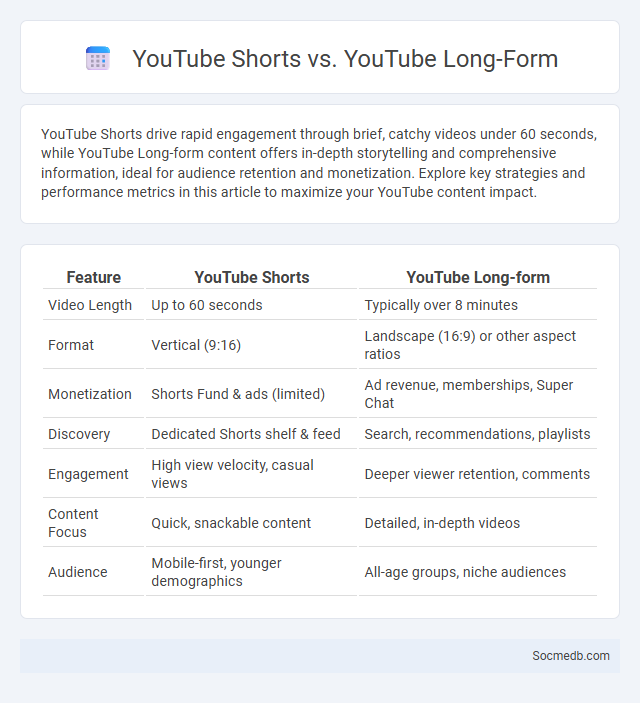
Photo illustration: YouTube Shorts vs YouTube Long-form
YouTube Shorts drive rapid engagement through brief, catchy videos under 60 seconds, while YouTube Long-form content offers in-depth storytelling and comprehensive information, ideal for audience retention and monetization. Explore key strategies and performance metrics in this article to maximize your YouTube content impact.
Table of Comparison
| Feature | YouTube Shorts | YouTube Long-form |
|---|---|---|
| Video Length | Up to 60 seconds | Typically over 8 minutes |
| Format | Vertical (9:16) | Landscape (16:9) or other aspect ratios |
| Monetization | Shorts Fund & ads (limited) | Ad revenue, memberships, Super Chat |
| Discovery | Dedicated Shorts shelf & feed | Search, recommendations, playlists |
| Engagement | High view velocity, casual views | Deeper viewer retention, comments |
| Content Focus | Quick, snackable content | Detailed, in-depth videos |
| Audience | Mobile-first, younger demographics | All-age groups, niche audiences |
Introduction to YouTube Shorts and Long-form Content
YouTube Shorts offers a dynamic platform for creating and sharing brief, engaging videos up to 60 seconds, designed for quick consumption on mobile devices. Long-form content on YouTube enables creators to produce detailed videos exceeding 10 minutes, ideal for in-depth tutorials, storytelling, and comprehensive reviews. Combining Shorts with long-form videos helps maximize audience reach and engagement by catering to diverse viewer preferences across the YouTube ecosystem.
Defining YouTube Shorts: Features and Audience
YouTube Shorts are vertical, short-form videos lasting up to 60 seconds, designed to capture quick, engaging content suitable for mobile viewers. This feature targets a diverse audience, primarily Gen Z and Millennials, seeking fast-paced entertainment and bite-sized information. Leveraging YouTube's existing ecosystem, Shorts integrates seamlessly with the platform's algorithm to boost content discoverability and creator visibility.
Understanding YouTube Long-form Videos
YouTube long-form videos, typically exceeding 10 minutes, provide creators with enhanced opportunities for deeper storytelling, audience engagement, and monetization through ads and memberships. Understanding viewer retention metrics and content quality is essential to optimize these videos for algorithm favorability and search visibility. Your ability to craft compelling narratives and maintain viewer interest directly impacts channel growth and revenue potential.
YouTube Monetization: How Ad Revenue Works
YouTube monetization generates revenue primarily through ad placements on videos, utilizing Google AdSense to display targeted advertisements based on viewer demographics and behavior. Content creators earn a share of ad revenue based on factors such as video views, ad engagement, and advertiser bids in the platform's auction system. YouTube's Partner Program requires creators to meet eligibility criteria, including at least 1,000 subscribers and 4,000 watch hours in the past 12 months, to access monetization features.
Shorts vs Long-form: Content Creation Strategies
Creating engaging content on social media requires balancing Shorts and Long-form videos to maximize reach and retention. Shorts, typically under 60 seconds, capture immediate attention and boost viral potential on platforms like TikTok, Instagram Reels, and YouTube Shorts. Long-form content provides deeper storytelling and builds stronger connections with your audience by offering detailed insights and sustained engagement.
Audience Engagement: Shorts vs Long-form Performance
Social media audience engagement varies significantly between shorts and long-form content, with shorts typically generating higher interaction rates due to their quick, digestible format ideal for mobile viewing. Brands leveraging shorts on platforms like TikTok and Instagram Reels see increased shares, comments, and growth in follower count, while long-form videos on YouTube provide deeper storytelling opportunities leading to stronger viewer retention and loyalty. Tailoring your strategy to balance shorts for reach and long-form for engagement maximizes your overall social media performance and audience connection.
Ad Revenue Potential for YouTube Shorts
YouTube Shorts offers significant ad revenue potential driven by its rapidly growing viewer base and high engagement rates. Brands leverage short-form video ads integrated into Shorts to reach millions of active users, boosting monetization opportunities for creators. Your ability to produce compelling, concise content can maximize earnings through targeted advertisements and increased viewer retention.
Ad Revenue Potential for Long-form YouTube Videos
Long-form YouTube videos offer significant ad revenue potential due to their extended watch time, which increases the number of mid-roll ads that can be inserted, boosting overall earnings. You can capitalize on higher viewer engagement and retention rates, essential metrics that advertisers value when allocating budgets. By optimizing your video content for these factors, your channel can generate substantial and consistent income from multiple ad placements.
Comparing CPM and RPM for Shorts and Long-form
Understanding CPM (Cost Per Mille) and RPM (Revenue Per Mille) is crucial when monetizing social media content, especially when comparing Shorts and long-form videos. Shorts typically have lower CPM rates due to their brief format and rapid consumption but may generate higher RPM through increased viewer engagement and volume. Your content strategy should balance these metrics to maximize revenue streams by leveraging the strengths of both Shorts and long-form videos.
Choosing the Right Format for Maximum Ad Revenue
Selecting the ideal social media format significantly boosts ad revenue by aligning content style with audience preferences and platform algorithms. Video ads typically generate higher engagement rates and click-through percentages compared to static images, making them a lucrative choice for advertisers on platforms like Instagram and TikTok. Implementing interactive formats, such as Stories or carousel ads, can increase viewer interaction and improve conversion metrics, maximizing advertising ROI.
 socmedb.com
socmedb.com